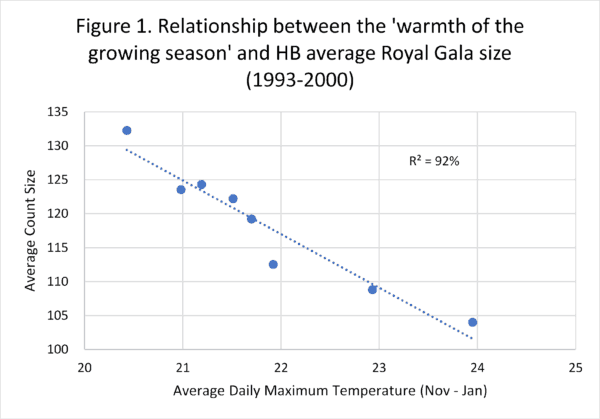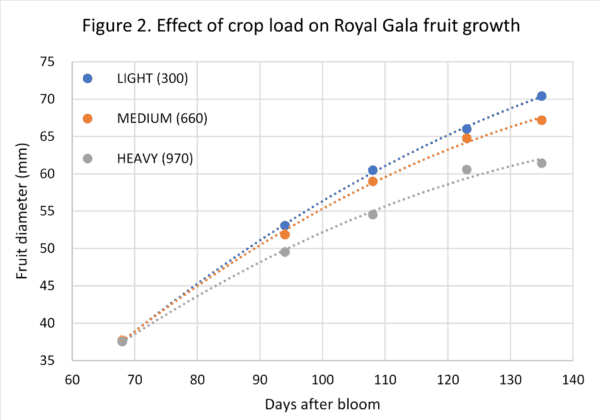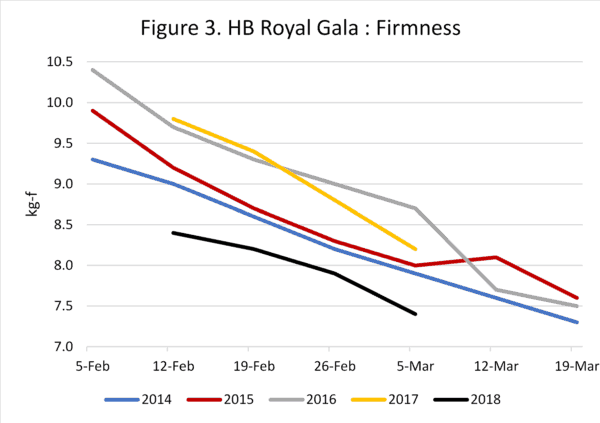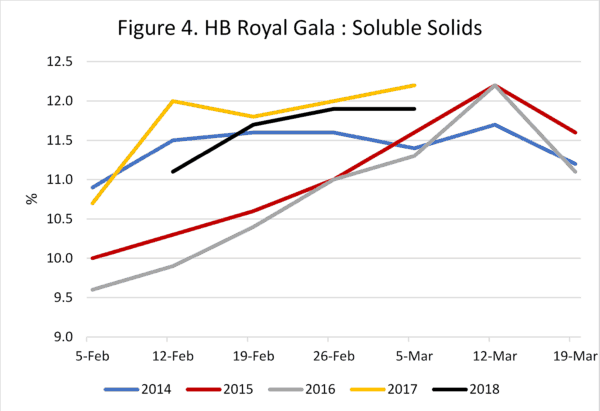What influences Royal Gala fruit size, maturity and quality?
As first seen in the Orchardist, February 2019
Jack Hughes, Horticultural Consultant Fruition Horticulture, Hawke’s Bay
I sit down to write this article in mid January, 2019. Its that time when New Year’s Resolutions are already under threat. The weather has been all over the place – hot, dry, sunny, cloudy and WET. Hell for Summerfruit, meantime there’s a big crop of apples chugging along towards harvest. What might we expect?
Royal Gala is a good variety to consider given that it is our most planted variety and as an early season apple, it is strongly influenced by summer growing conditions. Phenology is the scientific term for the study of the effects of climate on plant life – historical data tells us that Royal Gala bloom and harvest dates vary a lot.
The average bloom date for Royal Gala not treated with dormancy breakers in Hawkes Bay over the past 32 years is 9 October but there is a massive spread of 25 days from the earliest season (27 Sept) until the latest (22 Oct). The distribution of bloom dates is also ‘lumpy’ rather than ‘normal’. Similarly, the average start of harvest date (when average starch pattern index reaches GO over a sample of blocks in the Heretaunga Plains) for 21 years of available data is 21 February. Again, there is a large spread of 29 days from the earliest season (9 Feb) until the latest (10 March).
It gets even more interesting when the average length of each growing season (bloom to harvest) is considered. While the average number of days is 135, the Hawkes Bay crop has reached maturity in a minimum of just 124 days and has taken as long as 151 – a spread of 27 days! What drives these processes and would anyone care to make predictions about the upcoming crop? 
Dr Zhang was a biometrician at AgricultureNZ in the early 2000’s. He used regression analysis to try and determine cause and effect and showed that temperature was a strong driver of Royal Gala fruit growth and maturation. Zhang concluded that ‘heat’ as measured by average daily maximum temperatures (ADMT) was a better descriptor than ‘growing degree days’ which include daily minimums and an arbitrary base value in their calculation. Zhang found that the Royal Gala harvest was advanced by hotter ADMT’s in the latter part of the growing season ie January-February.
He also showed that Royal Gala grew larger in seasons when the ADMT’s from November to January were higher (Figure 1).
This historical data is helpful to illustrate the drivers of fruit growth, but things have changed. These days, with the emergence of better markets for small to medium sized fruit, the focus includes crop volume as well as size. Larger volume crops and the use of dormancy breakers and other tools have made things more complicated. The relationship still holds over the last 21 seasons although it is weaker (R2=55%, data not presented).
As Royal Gala crop load increases, fruit growth rates at the end of the season reduce. ‘Hitting the wall’ is a more common and colourful, if exaggerated, way of putting it. Figure 2 shows the effect of crop load on fruit diameter over three different crop loads established by hand thinning (unpublished data).

Note that the numbers following the crop load description describe the number of fruit per hectare in thousands ie Light (300) = 300,000 fruit per hectare. This data was collected in 1997, a cool, small fruit size growing season. Fruit growth rates tend to taper off as crop load level increases with this effect showing up earlier and more strongly at higher loads.
Post Harvest
Seasonal growing conditions also affect the post-harvest quality of the crop but again understanding what influences fruit firmness and soluble solids is not always obvious. There appears to be a pronounced seasonal effect on these parameters for Royal Gala (Figure 3. Source: HB Maturity Monitoring data, NZAP). Each season, there is a consistent rate of softening as fruit matures over the harvest interval and there are differences between seasons. Fruit size is a factor here as smaller fruit tend to be firmer. Seasons that favour rapid late season fruit growth at the end of the growing season result in larger size, but these conditions don’t favour desirable higher firmness – think 2018.

Soluble solids also show a pattern of steady increase as fruit matures. The exceptions being very late sampled fruit at the end of the harvest window when only the poorest fruit from the inside of canopies remains. Again there are also seasonal differences.
Of course, higher soluble solids at harvest don’t necessarily tell the out-turn story because fruit maturity status at harvest makes a difference. Less mature fruit (lower starch pattern index) have more starch to convert into sugar. These fruit will have higher soluble solids at out-turn as starch is converted into sugar during storage. On the other hand, more mature, tree ripened fruit have already converted most of their starch and so when they use their available sugars in respiration during storage they may out-turn at lower levels than they went in.
Crop load is also a factor influencing out-turn fruit sweetness. In the fruit growth study mentioned above, fruit from the heavy cropping trees was approximately 1.5% lower than fruit from the lighter cropping trees – certainly enough to diminish the taste experience.

Apparent seasonal differences in firmness and soluble solids are reduced somewhat when differences in maturity timing are taken into account. For example, when firmness and soluble solids are compared at a similar starch pattern index (2.6, the start of harvest), the firmness range between the 5 seasons shown is reduced from a range of 8.0 – 8.8 kg and the soluble solids from 11.3 to 12.0 %. Still, season 2017 beats 2018 in terms of firmness and soluble solids hands down.
Predictions ain’t easy
At the time of writing, season 2018-19 has been very ‘normal’ on most counts. Bloom date for untreated Royal Gala on the Heretaunga Plains was 12 October, just a few days later than the long-term average and a week later than the previous season. On the temperature front, ADMT’s in November and December have been very close to average. January is well ahead of normal at the halfway stage so is likely finish up warmer than normal which would make 2019 very similar to 2018. Rainfall during the growing season has exceeded normal annual totals so soil moisture will hardly be a limiting factor except for possibly poor irrigation in lighter soils. So we are set up for good fruit sizing heading into harvest.
These factors put us on track for a slightly late start to the Royal Gala harvest but giving large yields of moderately sized fruit. Having said that, prediction is a tough game as a lot can happen between now and then. It would be much easier to wait for things to happen and give consensus explanations with the benefit of hindsight!
Reference
J. Zhang, D. Litchwark, J.Hughes, Apple maturity sampling and prediction (2001). A Technology for Business Growth Project. Hawkes Bay Apple Maturity Group